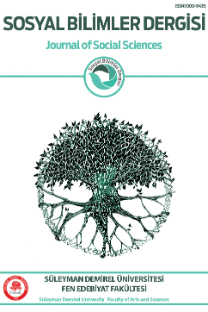Bauman’ın Sosyolojisi ve (Sosyal) Bilime Bıraktığı Miras
Bu çalışma, Zygmunt Bauman’ın genelde sosyal bilimlerde özel de ise sosyolojde meydana getirdiği etkiyi ortaya koymayı amaçlamaktadır. Bu etkiyi görebilmek için Bauman’ın Web of Science (WOS) veri tabanında yer alan çalışmaları ile bu çalışmalara atıf yapan yayınlar incelenmiştir. Bauman’ın kendi araştırmaları temel bir dizi tema altında yoğunlaşıyor görünse de, anahtar kelime analizlerinden de anlaşılacağı üzere, bunlardan yararlanılarak üretilen metinler Antropoloji, Edebiyat, Tarih, Felsefe, Uluslararası İlişkiler, İşletme ve Ekonomi, Kent Araştırmaları, Kamu Yönetimi ve Eğitim gibi oldukça geniş bir araştırma alanına yayılmıştır. Günümüzde Bauman’ın etki alanı Psikoloji, Etik ve İletişim sahalarına yaptığı katkılarla iyiden iyiye genişlemiştir ve küreselleşme, kitle kültürü, yeni medya, toplumsal eşitsizlik, göç gibi pek çok konuda yapılan araştırmalarda görüşlerine yer verilmektedir. Ortaya konulan tablo ve grafikler hem onun bilim dünyasındaki konumunu belirginleştirmekte hem de etiklerinin artarak devam edeceğine yönelik güçlü bir tahmine imkân vermektedir.
Anahtar Kelimeler:
Zygmunt Bauman, Sosyoloji, Sosyal bilimler, , Bibliyometri
Bauman's Sociology and his Legacy in (Social) Science
This study aims to reveal the effects of Zygmunt Bauman on social sciences in general and sociology in particular. In order to see these effects, Bauman's work in the Web of Science (WOS) database and publications referring to these studies have been examined. Although Bauman's own research seems to be focused on a number of basic themes, as is the case with visualization developed on the keywords, the texts produced via them have spread to a wide range of research fields such as Anthropology, Literature, History, Philosophy, International Relations, Business and Economics, Urban Studies, Public Administration and Education. Today, Bauman's domain of influence has expanded considerably with his contributions to psychology, ethics and communication fields and his views in researches are included many subjects such as globalization, mass culture, new media, social inequality and migration. The tables and graphics that are presented here make clear his position in the scientific world and allow us to make a strong prediction that his effects will continue to increase.
Keywords:
Zygmunt Bauman, Sociology, Social sciences, , Bibliometrics,
___
- Ahmad, I. (2017). Adieu, Zygmunt Bauman! Retrieved from http://www.aljazeera.com/indepth/opinion/2017/01/adieu-zygmunt-bauman-170112131157266.html
- Al, U., Soydal, I., ve Yalcin, H. (2010). An Evaluation of the Bibliometric Features of bilig. Bilig (55), 1-20.
- Alhajj, R., ve Rokne, J. (2014). Encyclopedia of social network analysis and mining
- Allen, A. T. (1997). The Holocaust and the modernization of gender: A historiographical essay. Central European History, 30(3), 349-364.
- Bancroft, A. (2000). Closed spaces, restricted places: the resurgence of politics in the work of Zygmunt Bauman. Contemporary Politics, 6(3), 283-288.
- Başer, D., ve Hülür, H. (2015). Akışkan modernitede yabancının durumu: hiç kimseleşme süreci. The Journal of Academic Social Science Studies(35), 399-410.
- Bastian, M., Heymann, S., ve Jacomy, M. (2009). Gephi: an open source software for exploring and manipulating networks. Icwsm, 8, 361-362.
- Bauman, Z. (1996). Yasa Koyucular ile Yorumcular (1. Basım). İstanbul: Metis Yayınları.
- Bauman, Z. (1998). Sosyolojik Düşünmek (1. Basım). İstanbul: Ayrıntı Yayınları.
- Bauman, Z. (1999). Çalışma, Tüketicilik ve Yeni Yoksullar. Istanbul: Sarmal Yayınevi.
- Bauman, Z. (2005). Bireyselleşmiş Toplum. İstanbul: Ayrıntı Yayınları.
- Bauman, Z. (2014). Modernite, Kapitalizm, Sosyalizm: Küresel Çağda Sosyal Adaletsizlik (2. Basım). İstanbul: Say Yayınları.
- Bauman, Z. (2016). Küreselleşme: Toplumsal Sonuçları (6. Basım). İstanbul: Ayrıntı Yayınları.
- Beilharz, P. (2000). Zygmunt Bauman: dialectic of modernity. London: Sage.
- Blackshaw, T. (2005). Zygmunt Bauman. New York: Routledge.
- Callon, M., Courtial, J.-P., Turner, W. A., ve Bauin, S. (1983). From translations to problematic networks: An introduction to co-word analysis. Information (International Social Science Council), 22(2), 191-235.
- Hughes, B. (2002). Bauman's strangers: Impairment and the invalidation of disabled people in modern and post-modern cultures. Disability & Society, 17(5), 571-584.
- Jacomy, M., Venturini, T., Heymann, S., ve Bastian, M. (2014). ForceAtlas2, a continuous graph layout algorithm for handy network visualization designed for the Gephi software. PloS one, 9(6).
- Karner, C., ve Aldridge, A. (2004). Theorizing religion in a globalizing world. International Journal of Politics, Culture, and Society, 18(1-2), 5-32.
- Lindenfeld, D. F. (1997). The prevalence of irrational thinking in the Third Reich: notes toward the reconstruction of modern value rationality. Central European History, 30(3), 365-385.
- Lyon, D. (2001). Everyday Life in Informational Societies: Uncertainties, Morals, and Zygmunt Bauman's Sociology. International Review of Sociology/Revue Internationale de Sociologie, 11(3), 383-393.
- Pritchard, J. (1969). Statistical bibliography or bibliometrics? Journal of documentation, 25(4), 348-349.
- Smith, D. (1999). Zygmunt Bauman: prophet of postmodernity. Cambridge: Polity Press.
- Tester, K. (2004). The social thought of Zygmunt Bauman. New York: MacMillan.
- Yalcin, H., ve Yayla, K. (2016). Scientometric Analysis of the Researches About Technological Pedagogical Content Knowledge and Scholarly Communication. Egitim ve Bilim-Education And Science, 41(188), 291-307.
- ISSN: 1300-9435
- Yayın Aralığı: Yılda 3 Sayı
- Başlangıç: 1995
- Yayıncı: Süleyman Demirel Üniversitesi, Fen-Edebiyat Fakültesi
Sayıdaki Diğer Makaleler
Bauman’ın Sosyolojisi ve (Sosyal) Bilime Bıraktığı Miras
Bologna Süreci, Avrupalılaşma ve TÜrk Yükseköğretimi: Alandan Bir Araştırma
Devrim Vural YILMAZ, Alper TÜTÜNSATAR
MORÇATI VE ŞEFKAT-DER ÖRNEĞİNDE KADINA YÖNELİK ŞİDDETLE MÜCADELEDE SİVİL TOPLUMUN ROLÜ
SONGÜL SALLAN GÜL, BÜŞRA ÖZEN, ÖZLEM KAHYA NİZAM
Türk Sosyolojisinde Ziyaeddin Fahri Fındıkoğlu
Teke Yöresi Endemik Bitkilerinin Sıcaklık ve Yağış Faktörleri ile İlişkisi
Kuzeybatı Pisidia Bölgesi (Seleukeia, Apollonia, Tymandos ve Konana) Alınlıklı Mezar Stelleri
Herbert Samuel döneminde Filistin'e Yahudi Göçleri (1920-1925)
